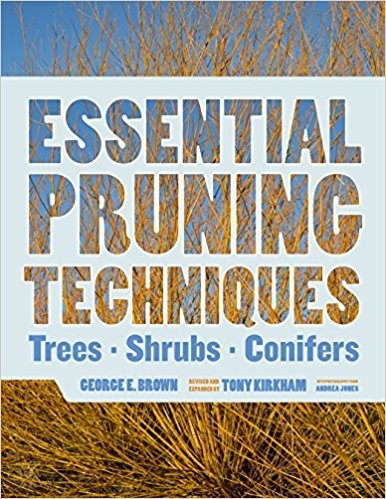Really Understanding Pruning
By George Graine, Fairfax Master Gardener
Good pruning is like good acting. It is invisible.
Karen Davis Cutler in The Why and When of Pruning (2003)
 If you have heard of George E. Brown, then you may know that his 1972 epic book The Pruning of Trees, Shrubs and Conifers was considered as the standard work on this subject. That was 45 years ago. In 1980 Brown passed away. His book was then revised and enlarged by Tony Kirkham in 2004. The expression “third time is the charm” is a familiar and apt expression because Kirkham has again revised and enlarged this book using a different title — Essential Pruning Techniques: Trees, Shrubs, and Conifers (Timber Press, 2017). This time Kirkham includes beautiful color photos by Andrea Jones that provide clarity and relevance to this definitive guide.
If you have heard of George E. Brown, then you may know that his 1972 epic book The Pruning of Trees, Shrubs and Conifers was considered as the standard work on this subject. That was 45 years ago. In 1980 Brown passed away. His book was then revised and enlarged by Tony Kirkham in 2004. The expression “third time is the charm” is a familiar and apt expression because Kirkham has again revised and enlarged this book using a different title — Essential Pruning Techniques: Trees, Shrubs, and Conifers (Timber Press, 2017). This time Kirkham includes beautiful color photos by Andrea Jones that provide clarity and relevance to this definitive guide.
Why does the book title use the word “essential”? Perhaps the answer is because our knowledge and understanding of plants change based on research findings. As an example, applying a tar-like substance to seal a pruning cut is passe’. Today, if a limb is pruned properly it will heal itself faster if no substance covers the wound. This is just one small example of the many changes noted in this comprehensive and up-to-date reference, encyclopedia-like book.
Pruning is often considered the number one task that vexes gardeners. To be clear, pruning is an indispensable part of garden maintenance, and it is also one of the most difficult when compared to weeding and deadheading plants. Successful pruning requires a thorough knowledge and understanding of the attributes of a plant’s growth and flowering/fruiting habits. Perhaps the old carpenter adage of measure twice and cut once is a variation of knowing what you are about to do before you pull out a pruning saw or pruner from your garden tool box. With improper pruning, you may disfigure or set back growth of a tree or shrub. You may even invite critters and disease problems if you do not use the correct pruning approach or your timing is off.
Note that some plants are best pruned in spring and some in fall and some not at all. The key to understanding pruning is to know how the plants are programmed by Mother Nature to express themselves, for example, grow tall, grow wide, need sun, type of soil and on and on. That means you need to know the cultural and environmental requirements of whatever you are planting. Your work as a gardener is to help the plant achieve its natural progression. In this regard, bonsai and topiary take an entirely different approach to pruning and are not the subjects of this book.
Kirkham begins his book with the general principles of pruning. This is like taking a survey course on the why, how and when to prune. Many photo images of well-pruned plants are displayed, and some include step-by-step pruning procedures. This is helpful as you will come away with a greater understanding of how and what you need to do to enhance the plant’s ultimate growth.
All of the almost 400 genera and species described are listed with their botanical Latin name. This is not to prove Kirkham’s level of sophistication but rather to avoid common plant name confusion. It is a fact that some plants are called by different names in other parts of the country. Using Latin nomenclature avoids any confusion. The newest edition of this book does not include an appendix of common names with their botanical equivalents. For example, crape myrtle is Lagerstroemia, dogwood is Cornus, holly is Ilex, arborvitae is Thuja and maple is Acer. The common–Latin name problem is easily resolved by using an electronic device. Enter the common name in the search box, and the botanical Latin name, as well as a variety of cultural aspects of the plant, will appear on the monitor. You may be pleased to know that Grainethumb found at least a dozen popular plants that had the same common name and botanical Latin name. A few examples are Hydrangea, Viburnum, Rhododendron, Forsythia and Nandina. Also know that some popular plants received more than a couple of explanatory paragraphs with color photos. Examples of these plants are Rosa (rose), Acer (maple), Cornus (dogwood) and Quercus (Oak).
To sum up, Essential Pruning Techniques clearly explains the principles of pruning. Included are profiles of woody plants from Abelia to Zenobia, along with advice on growth habit, attributes, reason for pruning and the best time to prune. This book is a must-have reference.